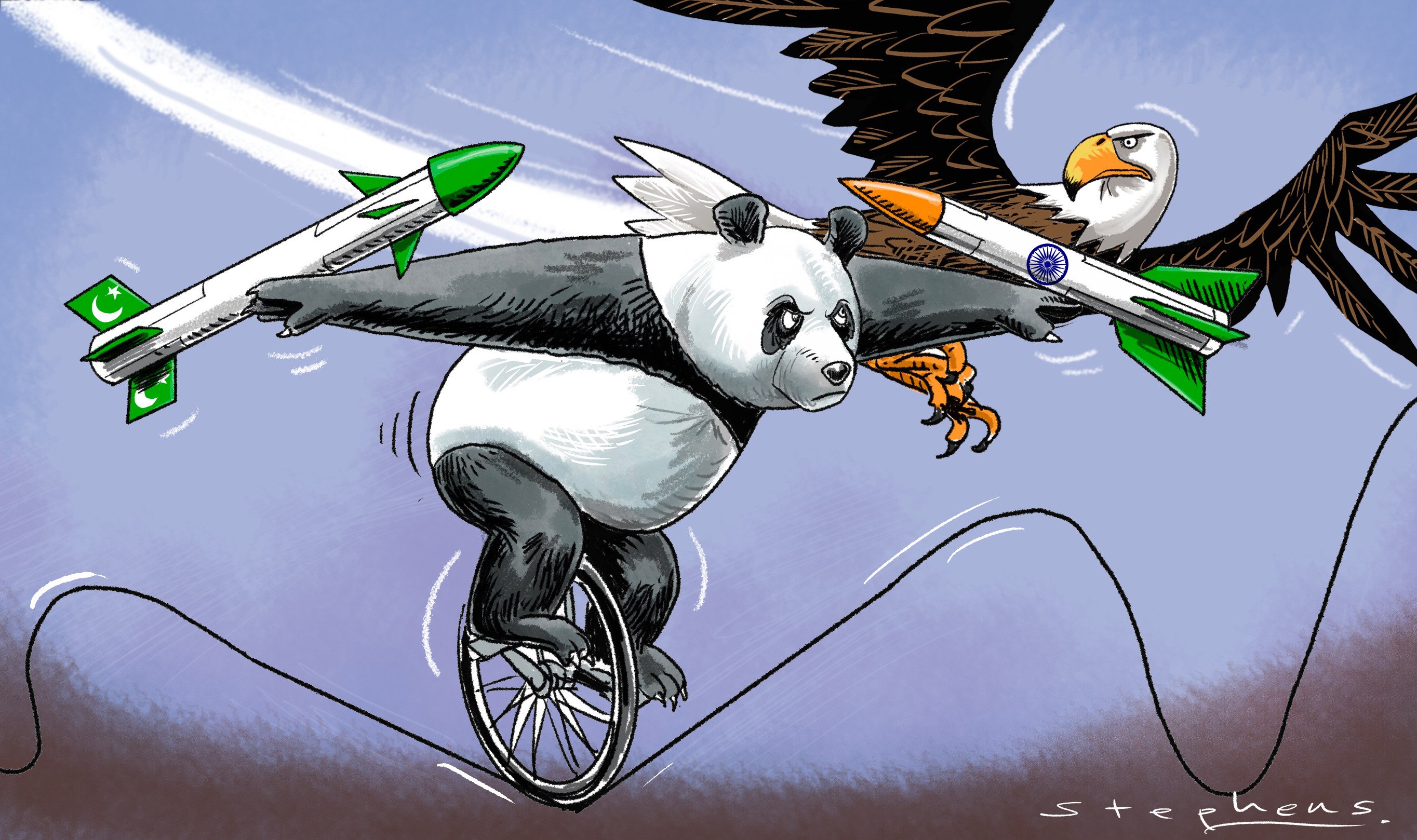China faces a tough balancing act with India and Pakistan
Beijing must juggle regional stability, global trade tensions and its standing as a responsible major power

India and Pakistan have agreed a truce after trading accusations over cross-border strikes and civilian casualties, but the risk of resumed escalation looms, with consequences extending far beyond the subcontinent.
Although US President Donald Trump is claiming credit for the ceasefire in this volatile theatre of conflict, China’s restrained and nuanced diplomacy reflects a strategic calculus rooted in regional stability, economic imperatives and global power dynamics. While the Chinese public cheers for Pakistan’s tactical gains, Beijing prioritises de-escalation over opportunism, recognising that a prolonged conflict threatens South Asia’s and China’s geopolitical and economic interests.
The immediate danger lies in a historically rooted collision between the two nuclear-armed rivals. The latest military exchange included artillery fire and air strikes. Pakistan said it downed five Indian warplanes, including three advanced French-made Rafale fighter jets, with its Chinese-made J-10C fighters. If the account is accurate, it underscores the regional race for military modernisation, with China’s J-10C fighters and PL-15 missiles representing Pakistan’s growing capabilities.
Yet the patriotic fervour on Chinese social media belies a solemn recognition that unchecked escalation risks catastrophic miscalculation. The Chinese Foreign Ministry has urged “calm and restraint” and avoidance of further complications, reflecting Beijing’s awareness that its own security along the border with India depends on containing neighbouring conflict.
The ceasefire does not address a quieter, brewing crisis: India’s April 23 suspension of the Indus Waters Treaty with Pakistan, which relies on the Indus river system for about 80 per cent of its agriculture. While India cannot actually cut off the flow of waters from the Western rivers, the Chenab, the Jhelum and the Indus main stem, it can stop sharing hydrological data and flood warnings. Such “hydrological warfare” transcends traditional conflict, in that it potentially puts a civilian population at risk, and risks destabilising the region.
China’s balancing act is further complicated by its multifaceted relationship with India. Despite historical tensions, New Delhi and Beijing share pragmatic common ground. Both are Brics members, while India’s alignment with China on Russia’s war with Ukraine and the recent Sino-Indian border de-escalation highlight a partnership forged despite the US’ efforts to drive a wedge between the world’s two most populous nations.
India’s potential as a counterweight in the US trade war must also be considered. For China, alienating India risks ceding influence in shaping a multipolar order, while overcommitting itself to Pakistan could estrange New Delhi, pushing India closer to the US – a dilemma magnified by India’s US$4 trillion gross domestic product and status as the world’s fastest-growing major economy.
Geoeconomically, the stakes are equally high. The China-Pakistan Economic Corridor, the linchpin of the Belt and Road Initiative, traverses conflict-prone regions where stability is non-negotiable. Pakistan’s procurement of Chinese artillery systems and fighters – needed to defend the corridor – highlights Beijing’s vested interest in trade routes.
Recurring clashes would threaten energy, rail and port projects in Pakistan, or US$62 billion in Chinese investment. More broadly, nearly US$200 billion in annual trade between South Asia and China, a major partner, hinges on regional peace.
The spectre of US interference adds another layer to China’s strategic calculus. To Beijing, Washington’s support for India’s military modernisation – including drone exports and proposed F-35 fighter sales – aligns with the US’ Indo-Pacific strategy for containing China. By stoking tensions, the US seeks to bog down China in South Asia while advancing trade coercion tactics.
Yet China’s response has been calibrated: while reaffirming its “ironclad” partnership with Islamabad, Beijing strengthened ties with New Delhi, resuming high-level interaction as bilateral trade reached US$127 billion in 2024-25. This duality allows China to hedge against US pressure without alienating either New Delhi or Islamabad.
Domestically, China faces tension between nationalist pride and pragmatism. While social media lights up over reports of Pakistan’s use of Chinese military hardware – and the positive implications for China’s defence industry – state media refrains from glorifying the conflict and instead emphasises mediation. This is in keeping with Beijing’s positioning of China as a “responsible stakeholder” in global governance, in contrast with the US’ transactional diplomacy.
But the clock is ticking on the non-military front. With the monsoon approaching, the humanitarian toll of prolonged conflict threatens to unravel South Asia’s fragile stability. China could call for enhanced regional cooperation on water governance. But success hinges on India resuming the water-sharing treaty – a critical step in de-escalating tensions and rebuilding trust.
It is in this broader context that Beijing has intensified consultations with Islamabad in recent years on pragmatic alternatives, including full support for infrastructure projects like the Diamer-Bhasha Dam, which could enhance Pakistan’s water storage capacity.
Instead of weaponising water resources, China may gain by advocating for multilateral consultation mechanisms, such as the arbitration framework under the Indus Waters Treaty, to resolve disputes transparently. Such steps align with Beijing’s aim to position itself as a neutral facilitator, balancing regional partnerships with a focus on stability.
In the India-Pakistan conflict, China faces a delicate dance. It has to walk a tightrope between ally loyalty and geopolitical pragmatism, while striking a balance between nationalist pride and statecraft.
While the temptation to exploit Pakistan as a testing ground for new Chinese weapons is real, the far greater prize lies in shaping a stable South Asia – one where the Belt and Road Initiative thrives, the Brics coalition strengthens and Beijing’s role as a global balancer is cemented.
Beijing’s efforts to step up mediation without slipping into partisanship and protect interests without feeding flames will define not just the outcome of this crisis, but its standing as a superpower in an increasingly fractured world.